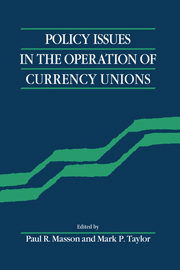1 - Currency unions: a survey of the issues
from I - Assessing the literature
Published online by Cambridge University Press: 04 August 2010
Summary
Introduction
A currency union may be defined as a geographical area throughout which a single currency circulates as the principal medium of exchange. Monetary, or exchange-rate unions, can be defined as areas within which exchange rates bear a permanently fixed relationship to each other. In the absence of capital controls, there can exist only one monetary policy in such areas. In the limit, such areas of exchange stability might also involve the replacement of the currencies of member countries by a common currency, that is, the formation of a currency union. The implications for monetary policy independence are however the same for monetary and currency unions, so the two will be treated together in what follows.
Interest in currency unions has grown steadily in recent years, following German unification and other developments in central and eastern Europe, as well as the emerging immediacy of the prospects for European Economic and Monetary Union (EMU). In our analysis, we discuss a number of issues relating to the operation of currency unions – in particular the conditions under which currency unions would be desirable and viable – and consider the operation of existing currency unions, in federal states and among regional country groupings.
Given the enormous recent growth in the relevant literature, it is inevitable that our chapter overlaps with several recent contributions, for instance, with the very comprehensive study by the EC Commission (1990), and with Eichengreen (1990a, 1990b).
Information
- Type
- Chapter
- Information
- Policy Issues in the Operation of Currency Unions , pp. 3 - 52Publisher: Cambridge University PressPrint publication year: 1993
Accessibility standard: Unknown
Why this information is here
This section outlines the accessibility features of this content - including support for screen readers, full keyboard navigation and high-contrast display options. This may not be relevant for you.Accessibility Information
- 30
- Cited by
